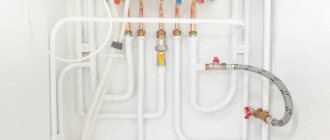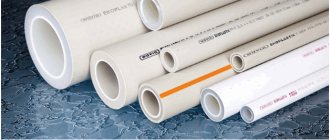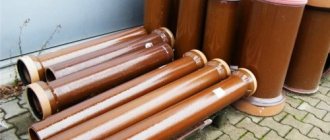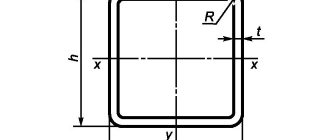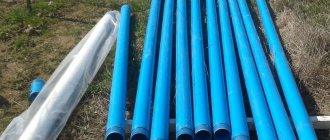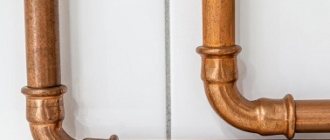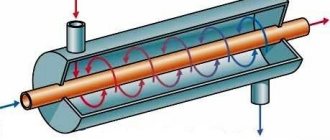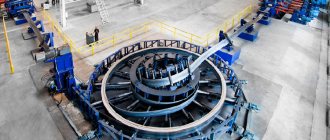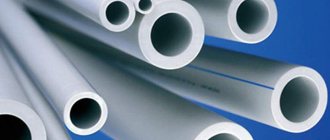You can order our services and products right now at tel.
.
Make a request
- home
- Pipes
- Large diameter pipes
A gas pipeline is a structure consisting of pipes through which any gaseous substances are transported. There are several types of gas pipelines, which are classified depending on the pressure exerted by the pumped substance on the structure:
- Low pressure;
- Medium pressure;
- High pressure category 1;
- High pressure category 2.
Products used for the installation of the transport system are carefully checked for the degree of curvature, which should not exceed 1.5 mm per 1 m of length, and the maximum permissible total curvature can be up to 0.2 percent of the entire length.
Types of gas pipes
The basis of safety is the gas pipe. Today, products made of steel, copper, and polyethylene are used.
Steel
The steel pipe, which became a classic during the Soviet Union, today faces competition from polymers. However, this type of pipeline is still used and has no alternative for external installation, as well as for the construction of intra-house networks. They are used in any climate, including areas with large differences in annual temperatures. Manufactured from low-carbon steel with low sulfur and fluorine content. There are two main types of pipes for gas pipelines made of steel:
- welded with a longitudinal straight or spiral seam;
- seamless seamless.
The disadvantages of steel gas lines are their heavy weight and the associated costs of delivery and installation, susceptibility to corrosion, the need for cathodic protection, and the difficulty of eliminating leaks (the need for welding). The products have restrictions on installation methods: threaded joints cannot be made underground, and flange connections are permissible only within special wells.
Copper
Approved for use in low pressure gas pipelines and can only be installed using press fittings. Compression fittings are prohibited; pipes must be marked yellow and have a yellow O-ring.
Their advantages are:
- high corrosion resistance;
- fairly simple installation with fittings and short deadlines;
- resistance to mechanical loads;
- durability;
- aesthetics - can be used without masking in open areas.
The main disadvantage is the high cost and inapplicability to work in high-pressure networks.
HDPE gas pipes
Low-density polyethylene (the correct name is high-density polyethylene) is a new generation product for the most critical highways. It is worth immediately noting that the term “low pressure” refers to the method of production of the material and has nothing to do with the characteristics of the pipeline. Such pipes for gas pipelines are suitable for transporting gas under pressure up to 1.2 MPa, are safe, reliable and are increasingly used both at federal facilities and in private construction. They have many features, so let’s look at them in more detail.
Documents regulating the assortment
GOST 3265-75 regulates the production of water and gas pipes. These pipes are used in the assembly of distribution systems for the supply of natural gas with an operating pressure of no more than 1.6 MPa. The diameter of such pipes does not exceed 15 cm, the length ranges from 4 to 12 meters.
GOST 8734-75 specifies the range of seamless cold-formed pipes. They are designed to operate under a pressure of 10 MPa. According to the document, pipes can have an outer diameter of no more than 25 cm and a length from 4.5 to 9 meters.
According to GOST 8732-78, you can select seamless hot-deformed pipe products. The document regulates the following pipe parameters: outer diameter size no more than 55 cm, wall thickness up to 7.5 cm, length from 4 to 12.5 meters. It is possible to install such pipes on main pipelines operating under high pressure.
Properties of HDPE gas pipes
Pipes for gas pipelines are made of two types of polyethylene - PE 80 and PE 100. The second is a “new generation” material, has a higher density compared to PE 80 and higher strength and performance characteristics.
The pipes are marked, which must include the manufacturer's trademark, name of the material (PE 63, PE 80, PE 100), SDR, diameter, wall thickness, date of manufacture and standard designation. The color of the pipes is black or black with longitudinal yellow stripes.
The cost of pipes for gas pipelines is higher than that of HDPE systems for sewerage or water supply. This is explained by higher requirements for raw materials (inadmissibility of using recyclable materials in production), as well as a longer certification cycle. At the same time, they are cheaper than steel pipes both in commercial form and when assessing the total costs of installation and operation over a 50-year period.
Advantages of HDPE products for gas pipelines
- Chemical resistance. They are immune to the transported medium and do not react with it.
- Corrosion resistance.
- Immunity to stray currents.
- Does not require cathodic protection. This stems from the first three points and significantly reduces installation time and cost.
- Constant throughput. The gap does not become overgrown with use due to the absence of corrosion and guarantees stable performance throughout the entire service life.
- Flexibility. The calculated permissible bending radius is 25 pipe diameters. This allows installation with fewer connections. Plus increases the safety of the finished highway in complex, heaving soils prone to movement under the influence of natural phenomena.
- Environmental Safety. Have no impact on the environment.
- Light weight. Noticeably lighter than steel. This reduces transportation and storage costs, and during installation allows you to use less lifting equipment.
- High strength and elasticity. Suitable for trenchless installation.
- Compatibility with other materials. Special shaped parts (fittings) make it possible to connect HDPE with other materials, including plastics, copper, and steel. This is convenient both when repairing and maintaining current pipelines, and when replacing worn areas with more affordable and easy-to-use PE pipes.
- Durability. The estimated service life is 50 years. Longer forecasts are limited only by the lack of operating experience. The expected service life, if conditions are met, can reach 100 years.
Disadvantages of HDPE gas pipes
The disadvantages are related specifically to the material of manufacture. These include a ban on use inside apartments, since polyethylene is a flammable material, as well as the impossibility of laying in open areas. Unfortunately, the issue of temperature stability for ethylene derivatives does not have a cost-effective solution, so operational limitations will remain.
Inner diameters
There is an accepted standard range that is taken into account by all countries that manufacture products for gas exhaust systems. Their internal diameters start from 6 mm. and can be more than 200 mm. Different indicators are taken for different species. There are standards for steel, seamless or polyethylene. They can be viewed in the size tables. For example, for the installation of structures in residential buildings, gas pipeline steel pipes with a diameter of 15, 20 and 32 millimeters are used. Most often, cast iron non-pressure elements with a diameter of 50 or 100 mm are used.
Nowadays, in the process of laying intra-house pipelines, polyethylene systems are more often used. They are gradually becoming more in demand and are replacing steel and cast iron products. It is important to note that the marking system depends on the material used in the pipe production process. Cast iron and steel are most often designated by internal diameter or nominal bore. External indicators are taken into account for copper, polymer and steel. And, when choosing pipes, you should pay attention to the thickness of its walls.
Thus, water and gas steel elements with GOST 3262-75 with an outer diameter from 15 to 50 mm. have wall thicknesses from 2.8 to 3.5 mm. Electric welded ones, manufactured according to standard 10704-91, have an external parameter from 57 to 159 mm, and a wall thickness from 3.5 to 6 mm. The external indicators of plastic pipes are from 10 to 32 mm. And the thickness of their walls can be completely different: 1.2, 1, 2.0, etc. Compliance data can be viewed on the manufacturers’ websites.
Similar standardization is used for non-galvanized steel, galvanized, with rolled or threaded threads, which are used for gas pipelines, water pipes, and heating systems.
Scope of application
Pipes for gas pipelines made from HDPE are used in almost all areas of business:
- small construction: for gasification of individual buildings and entire turnkey villages, including new and existing facilities;
- rehabilitation of existing highways;
- capital construction: to connect new houses and social facilities;
- industry: to meet the needs of production of various types and scales;
- agriculture: to meet the heating needs of crop and livestock farms;
- strategic objects: maintaining the functionality of storage facilities, creating auxiliary infrastructure for gas transport pipelines.
Scope of application of seamless pipe - pipeline construction
Seamless pipe refers to rolled pipe. Therefore, it is natural that the main purpose is the arrangement of various pipelines. Moreover, the production technology allows us to produce pipes that can withstand such characteristics of the working environment as:
- high pressure;
- elevated temperature;
- chemical composition.
Steam and certain liquids can be transported under very high pressure. Therefore, welded pipes are subject to deformation due to lower structural strength. Initially, the steam has a very high temperature, and sometimes the liquids move very hot. Thermal expansion occurs, which can lead to deformation of the structure. Seamless pipes for special purposes are available that can cope with this.
As for the chemical composition of the working environment, a number of substances can negatively affect the strength of the pipe. Sometimes some elements enter into a chemical reaction with the metal. This changes the composition of the fluid being moved.
Add to this the ability of seamless pipes to withstand various negative environmental factors. Plus a wide range of products, ranging from seamless tubes to main seamless pipes of huge diameters.
Based on this, the main directions of use are determined. Now we are talking about pipelines.
Features of installation work
Installation is carried out by butt or electrofusion welding using connecting parts with embedded heaters. The choice of welding method is determined by the diameter of the pipes, availability of access to the installation site, and budget requirements. Welding equipment can be rented, which allows you to reduce the cost of the finished pipeline if the project is a one-time project.
The manufacturer offers a wide range of complete shut-off and control valves and fittings for gas pipelines of any diameter, which makes it possible to easily install any section, including connection to existing steel pipes. If the technology is followed, the strength of the connections exceeds the strength of the pipe itself and guarantees the elimination of ruptures and other joint defects.
Qualified personnel who have been trained and regularly certified to work with welding equipment in accordance with the established work regulations are allowed for installation.
Advantages and disadvantages of steel pipes for gas pipelines
On the positive side, gas pipes are characterized by the following properties:
- High strength indicators.
- Insignificant linear expansion indicators.
- Ability to work with high pressure working environments.
- Reliable sealed connection, subject to the joining rules and absence of defects. Sometimes plastic pipes for gas are also used in a private home, which is worth reading about further.
Among the disadvantages of gas pipes are:
- The appearance of condensation due to high thermal conductivity.
- The likelihood of a corrosion process occurring.
- Inflexibility.
- Labor-intensive installation by welding.
Construction area of application of seamless pipe
The next huge area of using seamless pipes is construction. This type of rolled metal is actively used in the construction of various buildings and structures, and other objects. That is, wherever the construction of metal structures is required. Moreover, if seamless pipes with a round cross-section are used for pipelines, then in construction it is a little different. In addition to pipes with a classic round cross-section, profile seamless pipes are actively used. The use of welded structures made of pipes with square and rectangular profiles is especially important. It is pointless to list all building structures where seamless pipes can potentially be used. Everything is so variable, from the structural elements of buildings to the enclosing structures. That is, all the same factors as in the case of mechanical engineering. We are talking about high temperatures, high pressure, resistance to loads, and reduction in weight of the structure.
But there is one additional factor. This factor is called decorative properties. The pipe does not have a seam, which means it looks more attractive than a welded one. They take advantage of this by actively using seamless stainless steel pipes in the design of premises and the creation of small architectural forms. However, seamless pipes made of carbon steel grades with a special coating, for example, chrome-plated, are also used.
And they did not note another important area - the arrangement of engineering systems for various functional purposes. For example, seamless pipes are actively used in the construction of wells, as casing. This is discussed in more detail in the article “Seamless pipe for a well - relevance of use and selection rules.” And in addition to this, we also note gutters, storm drains, and drainage systems. There are other designs where the use of seamless pipes is relevant.
Installation
- How to install a gas pipeline in an apartment or private house?
In general, for any change in the configuration of gas equipment you need to contact Gorgaz. However, you and I are realists and we understand that it will take a long time to wait for a representative of this organization, and the price of the corresponding service will quite significantly hit the family budget.
Here are some simple tips that will help you avoid gas leaks and accidental damage to the gas pipe.
- Install the wiring under the ceiling. In this case, you will not touch the pipe when moving furniture;
The gas distribution is located under the ceiling of the room.
- As I recommended above, use maintenance-free connections whenever possible;
- Be sure to place a shut-off valve in front of the gas stove or boiler. I recommend using modern ball valves rather than obsolete plug valves. The purpose of the valve specifically for gas is indicated by the yellow marking on the body or handle;
Ball valve for gas.
- After installation, check each connection for gas leaks. The easiest way to do this is to apply soap suds to the fitting yourself. If there is a leak, it will begin to bubble.
Bubbling foam indicates a gas leak.
